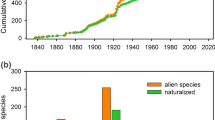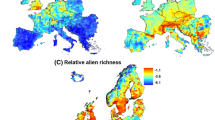Abstract
The spatial distribution of alien species richness often correlates positively with native species richness, and reflects the role of human density and activity, and primary productivity and habitat heterogeneity, in facilitating the establishment and spread of alien species. Here, we investigate the relationship between the spatial distribution of alien bird species, human density, and anthropogenic and natural environmental conditions. Next, we examined the relationship between the spatial distribution of alien bird species and native bird species richness. We examined alien species richness as a response variable, using correlative analyses that take spatial autocorrelation into account. Further, each alien bird species was examined as a response variable, using logistic regression procedures based on binary presence–absence data. A combination of human density and natural habitat heterogeneity best explained the spatial distribution of alien species richness. This contrasts with the results for individual alien species and with previous studies on other non-native taxa showing the importance of primary productivity and anthropogenic habitat modification as explanatory variables. In general, native species richness is an important correlate of the spatial distribution of alien species richness and individual alien species, with alien species being more similar to common species than to rare species.

Similar content being viewed by others
References
Anonymous (2001) Census 2001: key results. Statistics South Africa, Pretoria
Brooke RK, Lloyd PH, de Villiers AL (1986) Alien and translocated terrestrial vertebrates in South Africa. In: Macdonald IAW, Kruger FJ, Ferrar AA (eds) The ecology and management of biological invasions in southern Africa: proceedings of the national synthesis symposium on the ecology of biological invasions. Oxford University Press, Cape Town, pp 63–74
Case TJ (1996) Global patterns in the establishment and distribution of exotic birds. Biol Conserv 78:69–96. doi:10.1016/0006-3207(96)00019-5
Chown SL, Van Rensburg BJ, Gaston KJ, Rodrigues ASL, Van Jaarsveld AS (2003) Energy, species richness, and human population size: conservation implications at a national scale. Ecol Appl 13:1223–1241. doi:10.1890/02-5105
Clout MN (2002) Biodiversity loss caused by invasive alien vertebrates. Z Jagdwiss 48:51–58. doi:10.1007/BF02192392
Davies KF, Margules CR, Lawrence JF (2004) A synergistic effect puts rare, specialized species at greater risk of extinction. Ecology 85:265–271. doi:10.1890/03-0110
Dean WRJ (2000) Alien birds in southern Africa: what factors determine success? S Afr J Sci 96:9–14
Duncan RP, Blackburn TM, Sol D (2003) The ecology of bird introductions. Annu Rev Ecol Evol Syst 34:71–98. doi:10.1146/annurev.ecolsys.34.011802.132353
Emlen JT (1974) An urban bird community in Tucson, Arizona: derivation, structure, regulation. Condor 76:184–197. doi:10.2307/1366729
Evans KL, Gaston KJ (2005) People, energy and avian species richness. Glob Ecol Biogeogr 14:187–196. doi:10.1111/j.1466-822X.2004.00139.x
Evans KL, Warren PH, Gaston KJ (2005) Does energy availability influence classical patterns of spatial variation in exotic species richness? Glob Ecol Biogeogr 14:57–65. doi:10.1111/j.1466-822X.2004.00134.x
Evans KL, Van Rensburg BJ, Gaston KJ, Chown SL (2006) People, species richness and human population growth. Glob Ecol Biogeogr 15:625–636. doi:10.1111/j.1466-8238.2006.00253.x
Fairbanks DHK (2004) Regional land-use impacts affecting avian richness patterns in Southern Africa—insights from historical avian atlas data. Agric Ecosyst Environ 101:269–288. doi:10.1016/j.agee.2003.09.009
Fairbanks DHK, Kshatriya M, Van Jaarsveld AS, Underhill LG (2002) Scales and consequences of human land transformation on South African avian diversity and structure. Anim Conserv 5:61–73
Fine PVA (2002) The invasibility of tropical forests by exotic plants. J Trop Ecol 18:687–705. doi:10.1017/S0266467402002456
Gaston KJ (1994) Rarity. Chapman and Hall, London
Germaine SS, Rosenstock SS, Schweinsburg RE, Richardson WS (1998) Relationships among breeding birds, habitat, and residential development in greater Tucson, Arizona. Ecol Appl 8:680–691. doi:10.1890/1051-0761(1998)008[0680:RABBHA]2.0.CO;2
Gordon DR (1998) Effects of invasive, non-indigenous plant species on ecosystem processes: lessons from Florida. Ecol Appl 8:975–989. doi:10.1890/1051-0761(1998)008[0975:EOINIP]2.0.CO;2
Harrison JA, Allan DG, Underhill LG, Herremans M, Tree AJ, Parker V, Brown CJ (1997) The atlas of Southern African birds. Birdlife South Africa, Johannesburg
Hockey PAR, Dean WRJ, Ryan PG (2005) Roberts—birds of southern Africa, 7th edn. The Trustees of the John Voelcker Bird book Fund, Cape Town
Hodkinson DJ, Thompson K (1997) Plant dispersal: the role of man. J Appl Ecol 34:1484–1496. doi:10.2307/2405264
Hugo S, Van Rensburg BJ (2008) The maintenance of a positive spatial correlation between South African bird species richness and human population density. Glob Ecol Biogeogr 17:611–621. doi:10.1111/j.1466-8238.2008.00391.x
Irz P, Argillier C, Oberdorff T (2004) Natives and introduced fish species richness in French lakes: local and regional influences. Glob Ecol Biogeogr 13:335–344. doi:10.1111/j.1466-822X.2004.00109.x
Jokimäki J, Clergeau P, Kaisanlahti-Jokimäki M (2002) Winter bird communities in urban habitats: a comparative study between central and northern Europe. J Biogeogr 29:69–79. doi:10.1046/j.1365-2699.2002.00649.x
Kennedy TA, Naeem S, Howe KM, Knops JMH, Tilman D, Reigh P (2002) Biodiversity as a barrier to ecological invasion. Nature 417:636–638. doi:10.1038/nature00776
Kerr JT, Ostrovsky M (2003) From space to species, ecological applications for remote sensing. Trends Ecol Evol 18:299–305. doi:10.1016/S0169-5347(03)00071-5
La Sorte FA (2006) Geographical expansion and increased prevalence of common species in avian assemblages: implications for large-scale patterns of species richness. J Biogeogr 33:1183–1191. doi:10.1111/j.1365-2699.2006.01480.x
La Sorte FA, Boecklen WJ (2005) Temporal turnover of common species in avian assemblages in North America. J Biogeogr 32:1151–1160. doi:10.1111/j.1365-2699.2005.01271.x
Legendre P, Dale MRT, Fortin M, Gurevitch J, Hohn M, Myers D (2002) The consequences of spatial structure for the design and analysis of ecological field surveys. Ecography 25:601–615. doi:10.1034/j.1600-0587.2002.250508.x
Le Maitre DC, Richardson DM, Chapman RA (2004) Alien plant invasions in South Africa: driving forces and the human dimension. S Afr J Sci 100:103–112
Lennon JJ, Koleff P, Greenwood JJD, Gaston KJ (2004) Contributions of rarity and commonness to patterns of species richness. Ecol Lett 7:81–87. doi:10.1046/j.1461-0248.2004.00548.x
Levine JM, Adler PB, Yelenik SG (2004) A meta-analysis of biotic resistance to exotic invasions. Ecol Lett 7:975–989. doi:10.1111/j.1461-0248.2004.00657.x
Littell RC, Milliken GA, Stroup WW, Wolfinger RD (1996) SAS® system for mixed models. SAS Institute Inc., Cary, USA, pp 303–330
Lonsdale WM (1999) Global patterns of plant invasions and the concept of invasibility. Ecology 80:1522–1536
Low AB, Rebelo AG (1996) Vegetation of South Africa, Lesotho, and Swaziland. Department of Environmental Affairs and Tourism, Pretoria
Mckinney ML (2001) Effects of human population, area, and time on non-native plant and fish diversity in the United States. Biol Conserv 100:243–252. doi:10.1016/S0006-3207(01)00027-1
McKinney ML (2002) Do human activities raise species richness? Contrasting patterns in United States plants and fishes. Glob Ecol Biogeogr 11:343–348. doi:10.1046/j.1466-822X.2002.00293.x
McKinney ML, Lockwood JL (1999) Biotic homogenization: a few winners replacing many losers in the next mass extinction. Trends Ecol Evol 10:450–453. doi:10.1016/S0169-5347(99)01679-1
Mills GS, Dunning JB, Bates JM (1989) Effects of urbanization on breeding bird community structure in southwestern desert habitats. Condor 91:416–428
Morneau F, Décarie R, Pelletier R, Lambert D, DesGranges J, Savard J (1999) Changes in breeding bird richness and abundance in Montreal parks over a period of 15 years. Landsc Urban Plan 44:111–121. doi:10.1016/S0169-2046(99)00002-X
Neter J, Kutner MH, Nachtsheim CJ, Wasserman W (1996) Applied linear statistical models, 4th edn. Irwin, Illinois
Peacock DS, Van Rensburg BJ, Robertson MP (2007) The distribution and spread of the invasive alien common myna, Acridotheres tristis L. (Aves: Sturnidae), in southern Africa. S Afr J Sci 103:465–473
Pyšek P, Jarošík V, Kučera T (2002) Patterns of invasion in temperate nature reserves. Biol Conserv 104:13–24. doi:10.1016/S0006-3207(01)00150-1
Quinn GP, Keough MJ (2002) Experimental design and data analysis for biologists. Cambridge University Press, Cambridge
Rapoport E (2000) Remarks on the biogeography of land invasions. Rev Chil Hist Nat 73:367–380
Richardson DM, Bond WJ, Dean WRJ, Higgins SI, Midgely GF, Milton SJ, Powrie LW, Rutherford MC, Samways MJ, Schulze RE (2000) Invasive alien species and global change: a South African perspective. In: Mooney HA, Hobbs RJ (eds) Invasive species in a changing world. Island Press, Washington, DC
Richardson DM, Rouget M, Ralston SJ, Cowling RM, Van Rensburg BJ, Thuiller W (2005) Species richness of alien plants in South Africa: environmental correlates and the relationship with indigenous plant species richness. Ecoscience 12:391–402. doi:10.2980/i1195-6860-12-3-391.1
SAS Institute, Inc. (2004) SAS/STAT® 9.1 User’s guide. SAS Institute Inc., Cary, NC
Statsoft, Inc. (1999) STATISTICA for Windows. Statsoft Inc, Tulsa
Stohlgren TJ, Binkley D, Chong GW, Kalkhan MA, Schell LD, Bull KA, Otsuki Y, Newman G, Bashkin M, Son Y (1999) Exotic plant species invade hotspots of native plant diversity. Ecol Monogr 69:25–46
Stohlgren TJ, Barnett DT, Kartesz TJ (2003) The rich get richer: patterns of plant invasions in the United States. Front Ecol Environ 1:11–14
Stohlgren TJ, Barnett D, Flather C, Fuller P, Peterjohn B, Kartesz J, Master LL (2006) Species richness and patterns of invasion in plants, birds, and fishes in the United States. Biol Invasions 8:427–447. doi:10.1007/s10530-005-6422-0
Thompson M (1996) The standard land-cover classification scheme for remote-sensing application in South Africa. S Afr J Sci 92:34–42
Van Rensburg BJ, Chown SL, Gaston KJ (2002) Species richness, environmental correlates, and spatial scale: a test using South African birds. Am Nat 59:566–577. doi:10.1086/339464
Van Wilgen BW, Richardson DM, Le Maitre DC, Marais C, Magdalela D (2001) The economic consequences of alien plant invasions: examples of impacts and approaches to sustainable management in South Africa. Environ Dev Sustain 3:145–168. doi:10.1023/A:1011668417953
Vázquez LB, Gaston KJ (2004) Rarity, commonness, and patterns of species richness: the mammals of Mexico. Glob Ecol Biogeogr 13:535–542. doi:10.1111/j.1466-822X.2004.00126.x
Vitousek PM, Mooney HA, Lubchenco J, Melillo JM (1997) Human domination of Earth’s ecosystems. Science 277:494–499. doi:10.1126/science.277.5325.494
Williams JW, Seabloom EW, Slayback D, Stoms DM, Viers JH (2005) Anthropogenic impacts upon plant species richness and net primary productivity in California. Ecol Lett 8:127–131. doi:10.1111/j.1461-0248.2004.00706.x
Acknowledgments
The Avian Demography Unit (University of Cape Town) kindly provided the avian data. We thank Ingrid Booysen who prepared some of the mapped data used in the study. This work was funded by the University of Pretoria and the DST-NRF Centre of Excellence for Invasion Biology.
Author information
Authors and Affiliations
Corresponding author
Rights and permissions
About this article
Cite this article
Hugo, S., Van Rensburg, B.J. Alien and native birds in South Africa: patterns, processes and conservation. Biol Invasions 11, 2291–2302 (2009). https://doi.org/10.1007/s10530-008-9416-x
Received:
Accepted:
Published:
Issue Date:
DOI: https://doi.org/10.1007/s10530-008-9416-x




